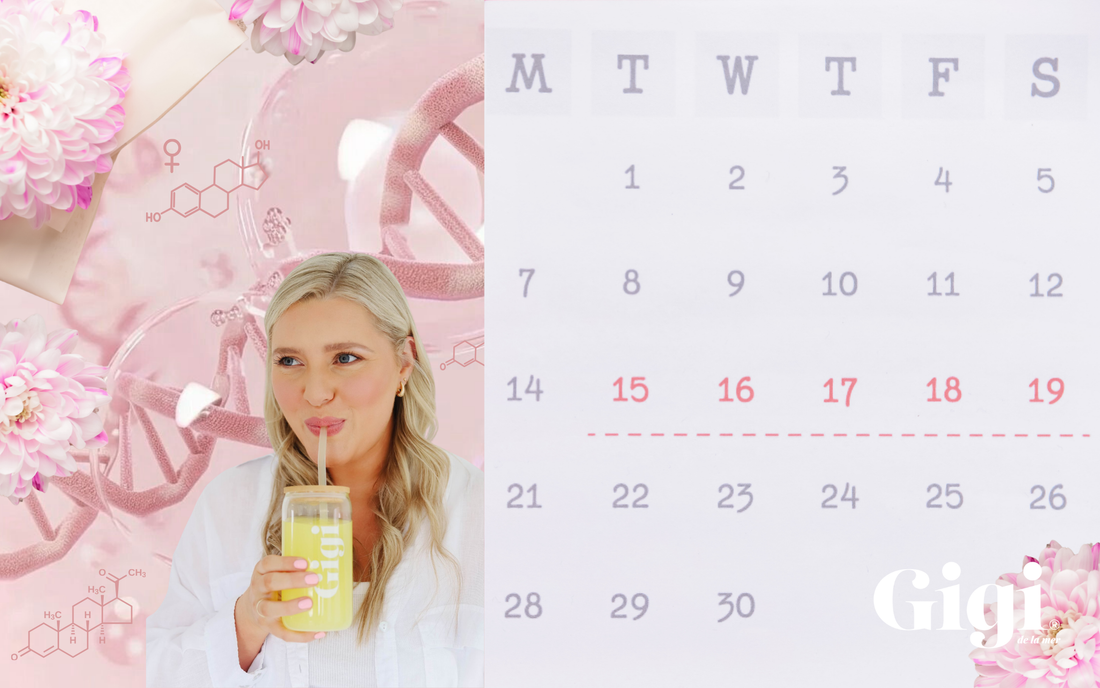At Gigi, we love talking about hormones and how to look after them – but we realised we haven’t fully broken down female hormones in a simple, easy-to-digest way. So, here’s your quick guide to hormones: what they are, what they do and the key female hormones you should know about.
Hormones: What Are They?
Hormones are naturally occurring molecules that act like messengers in your body. They regulate a huge range of important functions – from growth, hunger and thirst to mood, energy and even your skin.
These messengers are produced by the endocrine system, which sends them out to various parts of your body. They travel through your bloodstream, but hormones only affect cells with the right “receptor sites,” working together like a lock and key. Think of it as your body’s own messaging system – precise, powerful and essential for day-to-day functioning.
Hormones: What do they actually do in the body?
Your hormones are hard at work behind the scenes all day and their effects are often so seamless you barely notice them – until something feels off. From morning coffee to nighttime wind-down, here’s a glimpse of your hormones’ daily “to-do list”:
🌅 In the morning: our adrenal glands produce cortisol, your body’s stress hormone. Levels spike to help you wake up and get moving.
🥙 After food: after we eat each of our meals & snacks, our pancreas releases insulin to regulate blood sugar and keep your energy steady.
⚠️ Unexpected moments: slam on the brakes in traffic? Your adrenal glands pump out adrenaline (epinephrine) to help you react fast.
💤 Bedtime routine: as you wind down, your pineal gland produces melatonin, helping you fall asleep and stay in a deep, restorative sleep.
Key Female Hormones to Know
While all hormones play a role in keeping your body balanced, a few are especially important for women. These reproductive hormones, mainly produced by the ovaries, influence puberty, breast development, fertility, body hair growth, mood, energy and overall health.
🌸 Oestrogen
Oestrogen is a multitasking hormone best known for helping to regulate your menstrual cycle. However, it also supports brain, heart, vascular and urinary tract health, as well as influencing body fat distribution, skin and hair. When levels are out of balance, you might notice bloating, mood swings, fatigue or changes in your skin and hair.
⚠️ When Oestrogen is Too High
Oestrogen dominance refers to when oestrogen levels are too high relative to other sex hormones. This can lead to symptoms such as:
-
Irregular periods or abnormal vaginal bleeding
-
Bloating
-
Swollen or tender breasts
-
Weight gain
⚠️ When Oestrogen is Too Low
Low oestrogen levels can cause a variety of symptoms, including:
-
Irregular periods or fertility difficulties
-
Reduced bone density
-
Vaginal dryness
-
Hot flashes
-
Dry skin
🪷 Progesterone
Progesterone works closely with oestrogen to regulate your cycle and prepare your body for potential pregnancy – but just like oestrogen, it has other vital roles too. It supports neural function, helps regulate other hormones, impacts mental health and maintains bone density. Its naturally calming effect promotes good sleep, especially during the luteal phase.
Changes in progesterone levels, particularly before menstruation, can cause mood swings, irritability, tiredness and breast tenderness.
⚠️ When Progesterone is Too High
Excess progesterone is less common but can still affect your body. Symptoms may include:
-
Changes in weight or water retention
-
Fatigue
-
Bloating
-
Breast tenderness
-
Anxiety
⚠️ When Progesterone is Too Low
Low progesterone levels can cause a variety of symptoms, including:
-
Anxiety or mood changes
-
Breast tenderness
-
Difficulty getting or staying pregnant
-
Trouble sleeping
-
Headaches or migraines
-
Hot flashes
-
Irregular periods or spotting
-
Vaginal dryness
-
Weight gain
🥚 Luteinising Hormone (LH)
LH triggers ovulation and supports fertility. It stimulates the ovaries to produce oestrogen, triggers ovulation around the midpoint of your cycle, and then stimulates empty ovarian follicles to produce progesterone, which helps support early pregnancy.
⚠️ When LH is Too High
High LH can affect fertility and menstrual regularity. Common causes include PCOS, lifestyle factors (smoking, excess alcohol, over-exercising or nutrient deficiencies. Symptoms may include:
-
Difficulty getting pregnant
-
Shorter or longer menstrual cycles
-
Missed periods
-
Weight changes
-
Mood swings
-
Vaginal dryness
-
Hot flashes
-
Fatigue
-
Changes in sex drive
⚠️ When LH is Too Low
Low LH can disrupt ovulation, causing irregular, missed, or absent periods. Symptoms may include:
-
Delayed puberty
-
Irregular or absent periods
-
Fatigue
-
Reduced pubic or body hair
-
Difficulty producing breast milk
🌱 Follicle Stimulating Hormone (FSH)
FSH has two main functions. It stimulates the growth of ovarian follicles, the little sacs that hold eggs. And, it also helps regulate the menstrual cycle and supports hormone production. Balanced FSH is essential for healthy cycles and fertility.
⚠️ When FSH is Too High
High FSH levels in women are most commonly caused by a low ovarian reserve (reduced egg count) or ovaries that aren’t functioning properly. Symptoms mimic menopause:
-
Irregular or absent periods
-
Hot flashes and night sweats
-
Changes in skin and hair
-
Difficulty conceiving
⚠️ When FSH is Too Low
Low FSH levels can disrupt ovarian function and interfere with ovulation, potentially causing irregular or absent periods. Low FSH may also affect fertility and hormone balance, depending on the underlying cause. Symptoms of low FSH can include:
-
Irregular or missing periods
-
Difficulty conceiving
-
Delayed puberty
-
Low libido
-
Fatigue
-
Hot flashes
💗 Testosterone
Yes, women have testosterone too! It’s part of a group of hormones called androgens and plays an important role in regulating sex drive (libido), supporting bone and muscle mass and influencing fat distribution. It also contributes to menstrual cycle regulation, fertility, mood stability and the growth, repair and maintenance of reproductive tissues.
⚠️ When Testosterone is Too High
Excess testosterone, known as hyperandrogegism, can lead to:
-
Acne and oily skin, often around the jawline, back, and chest
-
Excess facial and body hair (hirsutism)
-
Thinning or loss of scalp hair (alopecia)
-
Irregular or absent menstrual cycles
-
Mood and libido changes
-
Deepening of the voice
-
Weight fluctuations
⚠️ When Testosterone is Too Low
Low testosterone in women can cause:
-
Reduced sex drive
-
Mood changes, anxiety or depression
-
Irregular periods
-
Fatigue and low energy
-
Increased body fat
-
Muscle weakness or loss of tone
-
Decreased bone density (osteoporosis)
-
Vaginal dryness
-
Changes in breast tissue
Wrapping it Up
Your hormones aren’t the enemy – they’re powerful messengers keeping your body in balance. Understanding how they work and spotting when things are off can help you feel more in control of your mood, energy, skin and overall health.
💡 Gigi Tip: Tracking your cycle, prioritising sleep, managing stress and eating balanced meals can support hormonal harmony.



